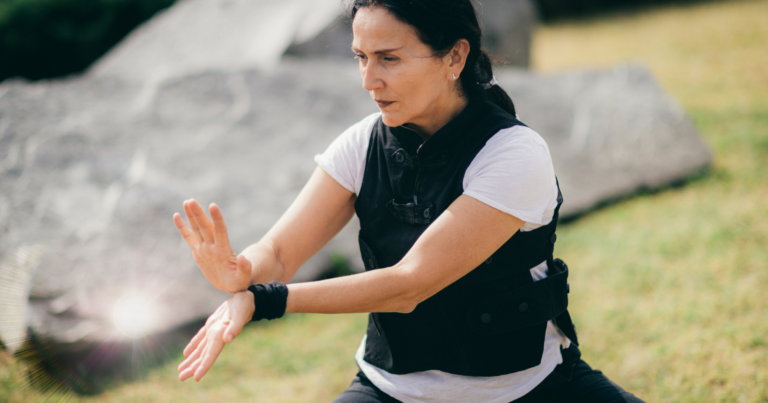Mindfulness exercises have become a daily necessity for many seeking stress reduction.
Usually, these exercises require minimal time commitment and can be easily integrated into your daily schedule, regardless of how busy you might be.
Integrating these practices into your routine can be transformative, fostering a calmer and more balanced state of mind.
Having explored and practiced various mindfulness techniques myself, I can attest to their positive impact.
In this article, I will walk you through 7 daily mindfulness exercises that you can easily incorporate into your regimen to help reduce stress and promote inner peace.
1) Mindful breathing
If I were to name the cornerstone of any mindfulness practice, it would be mindful breathing.
This technique is deceptively simple, yet it holds immense potential for stress reduction.
- To practice mindful breathing, find a quiet space free of distractions.
- Assume a comfortable position, close your eyes, and focus your attention on your breath.
- Notice the sensation of the air entering and leaving your nostrils, the rise and fall of your chest and abdomen.
The key here is to observe without judgment.
If your mind wanders, as it invariably will, gently guide it back to the breath.
As for me, I’ve found that even a few minutes of mindful breathing each day can significantly lower stress levels and promote a sense of calm and tranquility.
Moreover, this exercise can be easily incorporated into any daily routine – you can practice it upon waking, during breaks at work, or before bedtime.
It’s a versatile mindfulness tool that can help you navigate stressful situations with more ease and resilience.
2) Body scan meditation
Another proven mindfulness exercise I’d like to share is body scan meditation.
This technique involves slowly directing your attention through different parts of your body, from your toes to the top of your head.
As you do this, you observe any sensations, emotions, or thoughts associated with each area.
The beauty of body scan meditation lies in its grounding effect. By focusing on physical sensations, you anchor yourself in the present moment, a state that’s often elusive in our fast-paced world.
For instance, you might notice tension in your shoulders or restlessness in your legs. Instead of reacting or trying to change these sensations, you simply acknowledge them and move on.
This practice fosters a non-judgmental awareness of your body and its experiences.
For me, body scan meditation has been a powerful tool for reducing stress and enhancing body awareness.
The more you practice, the more attuned you become to your body’s signals, which can be invaluable in managing stress and maintaining overall well-being.
The science behind it?
Well, while there’s not much scientific evidence of this particular technique, mindfulness meditation, in general, can reduce cortisol levels – our primary stress hormone.
Since body scan meditation is based on similar principles, we can assume that it can have similar benefits for your holistic wellness.
3) Mindful eating
Now, you might be wondering, how can eating be a mindfulness exercise? Sounds a bit counterintuitive, right?
Yet, it’s surprisingly effective.
Mindful eating is all about fully immersing yourself in the experience of eating. This means savoring each bite, noticing the texture and flavor of your food, and paying attention to how it makes you feel.
In our often hectic lives, meals can become rushed or mindless. We eat while working, watching TV, or scrolling through our phones.
But by doing so, we miss out on the rich sensory experience that eating can offer.
When I began practicing mindful eating, I noticed a significant shift. Not only was I more present during meals, but I also found myself making healthier choices and truly appreciating my food.
Mindful eating can help reduce stress by redirecting your focus away from worries and towards something tangible and enjoyable – your meal.
It’s a simple yet powerful practice that can truly transform your relationship with food and stress.
So why not give it a try during your next meal?
4) Walking
Ever considered how much we take walking for granted?
Well, believe it or not, a simple walk can help you increase awareness.
The premise is straightforward – as you walk, you pay close attention to the physical experience.
The sensation of your feet touching the ground, the movement of your legs, the rhythm of your breath.
For some, it may seem odd to focus so intently on such a routine action. But therein lies the beauty of mindful walking. It pulls us away from our internal chatter and anchors us in the present moment.
Personally, I’ve found mindful walking to be a refreshing break from the constant sitting that characterizes our modern lifestyle. It’s an opportunity to connect with our bodies and our surroundings in a quiet, nonjudgmental way.
Not to mention, it’s a mindfulness exercise that you can do virtually anywhere – while commuting, during lunch breaks, or simply when you need a moment of calm in your day.

5) Journaling
Harnessing the power of the written word, mindful journaling is yet another tool you can add to your mindfulness toolkit.
This practice involves setting aside some time each day to write about your experiences, thoughts, and emotions with full awareness and without judgment.
The basic idea of journaling is that it helps you be present and honest with yourself as you write.
Don’t worry about punctuation, grammar, or coherence. This isn’t about creating a literary masterpiece.
It’s about expressing your authentic self on paper.
For me, mindful journaling has been instrumental in managing stress. It’s a safe space where I can vent my frustrations, celebrate my victories, and reflect on my growth.
Here are a few prompts to get you started:
- What am I grateful for today?
- What emotions am I feeling right now?
- What’s one thing I learned about myself today?
Remember, the goal of mindful journaling isn’t necessarily to find solutions to your problems. Rather, it’s about cultivating awareness and acceptance of your current state of being.
6) Mindful listening
I’d be remiss if I didn’t mention mindful listening — a practice that has personally helped me cultivate deeper connections and reduce stress.
In our busy lives, we often listen to respond rather than to understand.
We’re either planning our next reply, getting distracted by our own thoughts or allowing our biases to color our perception.
So, here’s my advice:
When engaging in conversation, give the other person your full attention.
Listen to their words, tune into their tone of voice, and observe their body language. And most importantly, put aside your own judgments and preconceived notions.
I can vouch for the transformative effect of mindful listening.
It not only enhances your relationships but also fosters a sense of inner peace and reduces stress by helping you stay grounded in the present moment.
7) Affirmation
Have you ever found yourself caught in a whirlwind of negative thoughts and emotions?
I certainly have, and it’s not a pleasant experience.
That’s when I turn to mindfulness affirmations – positive statements that help me shift my focus from stress and negativity to peace and positivity.
Mindfulness affirmations work by leveraging the power of our thoughts and words.
By repeating a positive statement, we can slowly but surely change our mindset and emotional state.
For instance, during stressful situations, I often use the affirmation: “I am calm and present.” This simple phrase helps me ground myself in the moment, fostering a sense of tranquility amidst the chaos.
What’s more, mindfulness affirmations are easily incorporated into your daily routine. You can recite them during your morning shower, on your commute, or before sleep.
It’s a quick yet powerful mindfulness exercise that can significantly reduce stress and promote a positive outlook.
Maintaining consistency and maximizing benefits
Now after discussing 7 simple exercises that can help you regulate stress, it’s time to reveal one secret that makes these exercises effective:
It’s maintaining consistency.
In this case, consistency means making mindfulness a part of your daily routine.
Here’s how you can do this:
- Set aside a specific time each day for your mindfulness exercises. Whether it’s morning, afternoon, or night, find what works best for you.
- Start small. Even a few minutes of practice each day can make a difference over time.
- Use reminders. Setting reminders on your phone or calendar can help you stick to your practice.
To maximize the benefits of your mindfulness exercises, it’s important to cultivate an attitude of patience and non-judgment.
Final words: Embracing mindfulness in everyday life
Mindfulness isn’t limited to meditation or yoga sessions. It’s a life skill that can be woven into the fabric of our daily lives, enhancing our experience of every moment.
These exercises we’ve explored – mindful breathing, body scan meditation, mindful eating, mindful walking, mindful journaling, mindfulness affirmations, and mindful silence – are not just tools for stress reduction.
They’re pathways to a more conscious and fulfilling existence.
By incorporating these mindfulness exercises into your routine, you’re taking a powerful step towards reducing stress and cultivating a deeper connection with yourself and the world around you.












